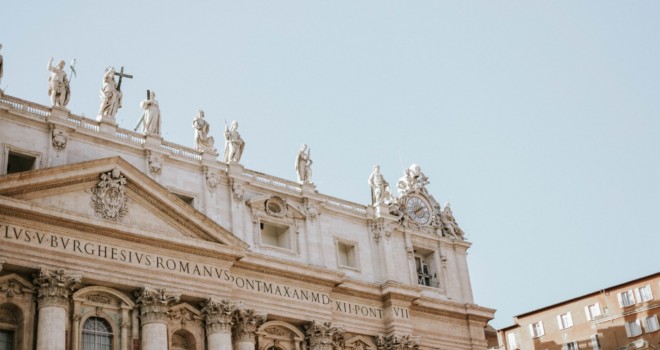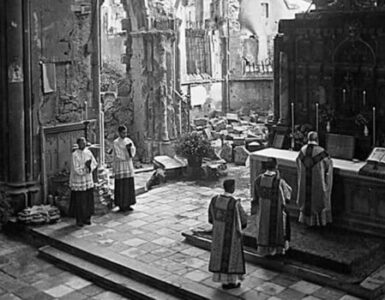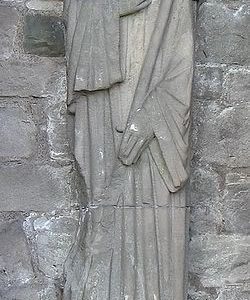The Second Vatican Council was an absolute bombshell. It made some big changes to a Church that a lot of people thought was never supposed to change, and theologians have been debating its significance ever since. In fact, many people think the council actually broke with previous Church teaching and contradicted what the magisterium had said before about some key issues, and one of the most discussed examples of this is the council’s teaching on the nature of the Church itself.
Vatican II expressed this teaching in a very different way than the magisterium ever had before, so it is easy to see why some people think the council changed the Church’s doctrine. However, a closer examination tells a different story, so let’s delve into this thorny issue and find out whether the Second Vatican Council really did break from the magisterium’s previous teaching on the nature of the Church.
Pre-Vatican II Teaching
Prior to Vatican II, magisterial documents identified the Catholic Church with the one true Church of Christ in a very simple way. For example, take a look at this quote from Pope Pius XIII, the immediate predecessor of the pope who called Vatican II (John XXIII):
“Some say they are not bound by the doctrine, explained in Our Encyclical Letter of a few years ago, and based on the Sources of Revelation, which teaches that the Mystical Body of Christ and the Roman Catholic Church are one and the same thing.” (Humani Generis 27)
Vatican II’s Teaching
In contrast, Vatican II takes a much more subtle and nuanced approach to this question. Here is the council’s teaching from its Dogmatic Constitution on the Church:
“This is the one Church of Christ which in the Creed is professed as one, holy, catholic and apostolic, which our Saviour, after His Resurrection, commissioned Peter to shepherd, and him and the other apostles to extend and direct with authority, which He erected for all ages as ‘the pillar and mainstay of the truth.’ This Church constituted and organized in the world as a society, subsists in the Catholic Church, which is governed by the successor of Peter and by the Bishops in communion with him, although many elements of sanctification and of truth are found outside of its visible structure.” (Lumen Gentium 8)
Unlike previous magisterial documents, Vatican II doesn’t say that “the one Church of Christ” simply is the Catholic Church. Rather, it says that this Church subsists in the Catholic Church, and that has led some people to suggest that the one Church of Christ can also subsist in Protestant and Orthodox churches as well. And if that is the case, then this is definitely a departure from what the Church had taught previously.
But is that really the case? Did the council really change the Church’s teaching on this important matter. No, it didn’t. Sure, Vatican II developed that teaching, and it captured an element of this truth that the Church’s earlier formulations didn’t express, but it didn’t contradict those previous formulations.
Substance, Elements, and Magisterial Affirmations
To see why, let’s start by looking at the wording of the council’s teaching. Immediately after saying that the one Church of Christ “subsists in the Catholic Church,” it explains that this is true “although many elements of sanctification and of truth are found outside of its visible structure.”
Does that sound like the council is teaching that the Church of Christ can subsist in other, non-Catholic churches? Not at all. It contrasts the way the Church of Christ “subsists” in the Catholic Church with the way “elements” of it are found in other churches, so it actually seems to be saying that the Church of Christ doesn’t subsist anywhere else.
And in case there is any doubt about this, the Magisterium has repeatedly affirmed this interpretation of the council’s words. They did so in 1985 in response to a theologian who made the exact mistake we’re talking about (Notification on the Book “Church: Charism and Power” by Father Leonardo Boff O.F.M.), they did it again in their 2000 document Dominus Iesus (DI 16), and they did it once more in a 2007 document called Responses to Some Questions Regarding Certain Aspects of the Doctrine on the Church. That is the official, authoritative interpretation of Vatican II’s teaching, so that is how we should take it as well.
Another Document
Finally, to really hammer the point home, let’s look at what I think is the most convincing evidence of all. If we look at a similar statement in another document from Vatican II, we will see that the council must have been developing rather than contradicting the magisterium’s previous teaching on this issue:
“The Holy Catholic Church, which is the Mystical Body of Christ, is made up of the faithful who are organically united in the Holy Spirit by the same faith, the same sacraments and the same government and who, combining together into various groups which are held together by a hierarchy, form separate Churches or Rites.” (Orientalium Ecclesiarum 2)
I do not know why this passage is not brought up more often in debates about this topic, but it should settle the matter entirely. By saying that the Church of Christ “subsists in” the Catholic Church, the council fathers were not abandoning the older teaching that the one true Church/Mystical Body “is” the Catholic Church. They used that earlier formula in another document, so they clearly weren’t rejecting it. Rather, they were nuancing it and expressing it in a way that allowed some room for the important truth that elements of the one true Church/Mystical Body can also exist outside the Catholic Church.
This obviously doesn’t settle all the controversy surrounding Vatican II. The council says a few other things that can be difficult (but not impossible!) to square with previous Church teaching, but on this issue, there should be no doubt. Vatican II didn’t change our belief about the nature of the Church. We still believe that the Catholic Church is the true Church of Christ, but we now add to that profession an acknowledgment that elements of the Church can exist outside its visible boundaries as well.
✠
Photo by Sonia Quintero on Unsplash












